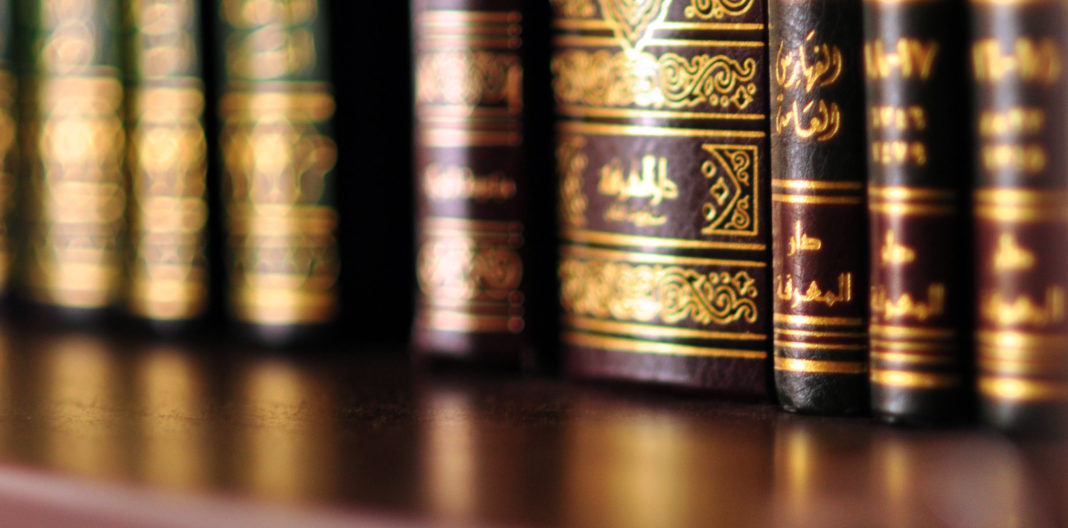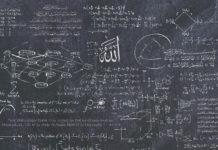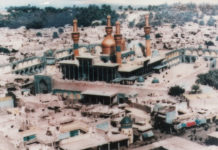The Circulation and Recording of Hadith: Section 1
The following is a lightly-edited selection from baḥth al-khārij (advanced jurisprudence) lectures of Sayyid Aḥmad Madadī, a respected jurist and student of Sayyid Abū l-Qāsim al-Khūʾī and SayyidʿAlī al-Sīstānī. He resides and teaches in the holy city of Qom.
This series of lectures deals with the history of the writing and circulation of hadith (tadwīn al-ḥadīth) in the Muslim world, as a precursor to his main discussion on taʿāruḍ al-adillah (dealing with the resolution of conflicting religious evidence). Sayyid Madadī did not intend this section of the lessons to be a detailed historical lecture. Rather, he intended to convey his own conclusions on tadwīn al-ḥadīth, and to prepare his students to understand his chosen method(s) for resolving taʿāruḍ al-adillah. As such, they can serve as a good starting place for further research into the history of Shiʿi hadith studies and as a survey of the discussions therein.
Introduction: TheʿUlamāʾ and their Transmitted Legacy
Shia and Sunniʿulamāʾ approach the sources of Islamic teachings in different ways, albeit with some overlap. Hadith discussions and research in the Sunni world, even from the very earliest of stages in their intellectual development, have revolved around a baḥth rijālī (narrator analysis). For example, Abū Ḥanīfah would accept mursal reports, while al-Shāfiʿī would not. It is even said that theʿulamāʾ used to act upon mursal reports until the time of al-Shāfiʿī, who rejected these reports as non-authoritative.[1]The acceptance of marāsīl (“detached”), traditions in which the contiguity of the narrators is not maintained, is a matter of dispute among Sunni jurists. The marasīl of tābiʿūn (“Successors,” i.e. the generation following the Companions) were accepted by Abū Ḥanīfah, Mālik b. Anas, Ibrāhīm al-Nakhaʿī, and others. They were rejected by al-Shāfiʿī, Aḥmad b. Ḥanbal, and the rest of Ahl al-Ḥadīth as a general rule. See: Majd al-Dīn Abū Sa‛ādāt al-Mubārak b. Muhammad Ibn al-Athīr, Jāmiʿ al-Uṣūl Fī Aḥādīth al-Rasūl, Vol. 1 (Irbid: Maktabah Dār al-Bayān, 1969), 117-119.
This is in contrast to the qudamāʾ (earlier scholars) of the Imami Shiʿa, who in their hadith-analysis originally focused on books and sources, engaging in what can be called baḥth fihristī (catalogue analysis). This does not mean they were not engaged in other forms of research. The Shia are indeed distinguished in having engaged both in baḥth fihristī, baḥth rijālī, and baḥth riwāʾī. However, the primary concern of the Shiʿi jurists and scholars of hadith was not the individual narrators. There is a clear distinction here between analyzing a text with regard to the individual narrators in the isnād (chain of narrators), as opposed to analyzing it through its written source and origin.
There are two tiers of discussions with regard to our riwāyāt. The first pertains to fahāris (catalogs of authors, singl. fihrist), where we examine the books of the companions and jurists and the ṭuruq (chains of authorities, singl. ṭarīqah) of their respective works. The second regards the narrations in our hadith compilations, such as al-Kutub al-Arbaʿah. For example, often Shaykh al-Kulaynī will present us with the following chain of narrators:
ʿAlī b. Ibrāhīm, from his father, from al-Nawfalī, from al-Sakūnī
With the repetition of this chain and with reference to the fihrist-texts, it becomes clear that the original source of this narration is the book of al-Sakūnī, a companion of Imam Ṣādiq (ʿa).[2]Al-Sakūni is the narrator’s nisbah (tribal affiliation). His name is Ismāʿīl b. Abū Ziyād; his father’s name was Muslim. Shaykh al-Ṭūsī mentions that al-Sakūnī was anʿāmmī (non-Shiʿi) but that the jurists of the sect (ṭāʾifah) acted on his reports. All of the chains of authorities (ṭuruq, singl. ṭarīqah) mentioned in the catalog of authors (fihrist, pl. fahāris) for the book(s) and riwāyāt of al-Sakūnī coalesce back to the same Ibrāhīm b. Hāshim mentioned in al-Kulaynī’s isnād. See: al-Sayyid Abū al-Qāsim al-Khūʾī, Muʿjam Rijāl al-Ḥadīth, vol. 4, 1st ed. (Najaf: Maktabah al-Tawzīʿ), 21-25 and 98-99.
The Akhbārīʿulamāʾ–mostly for polemical purposes–were among the most adamant in distinguishing between the meaning of the term “ṣaḥīḥ” (sound) per the ancient scholars (qudamāʾ) and its meaning according to the later scholars (mutaʾakhkhirīn)[3]At the forefront of this polemic, arguing in favor of this distinction was Mullā Muḥammad Amīn al-Astarʾābādī in his famous al-Fawāʾid al-Madaniyyah, where he contrasts the isnād-rijāl analysis of the later scholars for the sound hadith with any report of certain provenance from the maʿṣūm, regardless of its isnād, as the intent of the term among the qudamāʾ. See: Muḥammad Amīn al-Astarʾābādī and al-Sayyid Nūr al-Dīn al-ʿĀmilī, al-Fawāʾid al-Madaniyyah wa bi dhaylih al-Shawāhid al-Makkiyyah, 2nd ed. (Qom: Muʾassasah al-Nashr al-Islāmī, 1426/2005), 109-113. . Among the Shiʿa, the main agent of this switch from a baḥth fihristī to a complete and total baḥth rijālī isʿAllāmah Ḥillī.
For example, Shaykh al-Ṭūsī (r) mentions a narration fromʿAlī b. Jaʿfar, the youngest son of al-Ṣādiq (ʿa) famous for his collection of masāʾil from his brother Imam al-Kāẓim (ʿa), about how to purify a vessel a pig has drunk from:
Shaykh Mufīd reported to us from Abū al-Qāsim Jaʿfar b. Muḥammad, from Muḥammad b. Yaʿqūb, from Muḥammad b. Yaḥyā, from al-ʿAmrakī b.ʿAlī, fromʿAlī b. Jaʿfar, from his brother, Mūsā b. Jaʿfar (ʿa). He (ʿAlī b. Jaʿfar) said: I asked him (al-Kāẓim) about a pig that has drunk from a vessel. What is done with it? He said, “It is washed seven times.”[4]Muḥammad b. al-Ḥasan al-Ṭūsī, Tahdhīb al-Aḥkām, (Tehran: Dār al-Kutub al-Islāmiyyah, 1390/1970), 261, hadith 47-760
Both al-Kulaynī and al-Ḥimyarī–the author of Qurb al-Isnād–before him possessed the Masāʾil ofʿAlī b. Jaʿfar. Later, a different manuscript also reached al-Majlisī. However, this narration does not appear in any of these texts or manuscripts. In addition to this, Shaykh al-Ṭūsī himself does not produce a fatwa corresponding to this narration in any of his legal texts, nor does anyone after him give a fatwa according to it. The first jurist to rule based on this narration is Muḥaqqiq al-Ḥillī, who lived about two centuries after al-Ṭūsī, and his fatwa is only based on recommendation (istiḥbāb). The first to rule that it is obligatory to do so isʿAllāmah al-Ḥillī, because he understood this report to be sound per its chain of transmission. The fact that no extant manuscript ofʿAlī b. Jaʿfar’s work today contains this narration could mean one of two things:
1. Shaykh al-Ṭūsī made a mistake. For example, this report was a gloss in the margins of a manuscript of the Masāʾil, and he ascribed it to the text itself mistakenly.
2. This report was in al-Ṭūsī’s manuscript–meaning it is a mistake in the reporting of the text–and, therefore, has since been added to the original text.
If our primary focus for this report was rijālī, then our attention would be given to the individual narrators in the isnād. Thus, because we see that this report, as it appears in Shaykh al-Ṭūsī’s Tahdhīb al-Aḥkām, has reached us through a reliable isnād–that is, it is contiguous and from trustworthy narrators–it will be considered valid evidence in the derivation of law. However, if we pay attention to the original source of this narration–in other words, the hadith text it was originally sourced in–then our focus will be on the various manuscripts of that text, the text’s status/reception among the jurists and scholars of hadith, the different chains of authority mentioned in the fahāris, and so on.
Although the above hadith reported by al-Ṭūsī does not have any problems in its isnād, issues do surface when it is compared to the content utilized by other, earlier jurists from the various copies ofʿAlī b. Jaʿfar’s Masāʾil that were in circulation. Additionally, there is no fatwa in accordance with this particular report prior to the second half of the seventh century A.H. Thus, the sound isnād is insufficient evidence to establish the Imam as the source of the report. Conversely, if we have an isnād that may contain an unknown (majhūl) or even weak narrator, this apparent defect may be considered irrelevant due to the fame/renown of the original source for the hadith and the uniformity of source manuscripts that the jurists had access to.
In any case[5]For more insight into Sayyid Madadī’s ideas on baḥth fihristī see: Kāẓim Khalaf, “Manāhij al-Ijtihād wa Ṭarāʾiq al-Muhaddithīn ḥiwār maʿa al-Sayyid Aḥmad al-Madadī,” Markaz al-Buḥūth al-Muʿāṣirah fī Bayrūt, November 19, 2016, nosos.net/مناهج-الاجتهاد-وطرائق-المحدّثين. , it is necessary to fully grasp these discussions when learning how to deal with conflicting evidence, which is necessary to become a jurist. To do that, one must understand the intellectual legacy of the ancient scholars, which, in turn, requires us to understand the history of tadwīn (circulation) and writing of hadith. This discussion begins with looking at the history of Sunni hadith.
The Hadith and the Sunnah
As an introduction to this discussion, it is important to understand the distinction between sunna, hadith, and taḥdīth, terms often conflated by researchers. Taḥdīth is, very simply, the oral transmission of hadith. The sunnah (pl. sunan) of the Prophet (ṣ) is his legislation (tashrīʿ). For example, Allah mandated the five daily prayers, each originally two rakʿahs. Then the Prophet (ṣ) added two more rakʿahs to each, except Maghrib, to which he added just one rakʿah. The original two rakʿahs are from God’s legislation–the farḍ–while the obligatory additional rakʿahs are prophetic legislation through the legislative authority (wilāyah tashrīʿiyyah) delegated to him–that is, sunnah.[6]Muhammad b. Yaʿqūb al-Kulaynī, al-Kāfī, vol. 1 (Qom: Dār al-Ḥadīth, 1429/2008), 662-665, hadith 4-697
Another example is God’s forbidding the consumption of wine specifically and the Prophet (ṣ) then expanding that to the prohibition of all intoxicants.[7]Ibid. The phrasing for this in the hadith is the following: ḥarrama Allāhu –ʿazza wa jalla– al-khamra bi-ʿaynihā wa ḥarrama rasūlullāhi–ṣallallāhu ʿalayhi wa-ālihi–al-muskira min kulli sharābin. There is also the famous tradition instructing when the prayer is not to be repeated, referred to as the hadith of Lā Tuʿād (lit. “will not be repeated”) by theʿulamāʾ, narrated by Zurārah where Imam Bāqir (ʿa) mentions that the qirāʾah and tashahhud in ṣalāh are sunan and the sunnah does not overrule the farīḍah.[8]Muḥammad b.ʿAlī b. al-Ḥusayn ibn Bābuwayh al-Qummī, al-Khiṣāl (Qom: Markaz al-Manshurāt al-Islāmiyyah, 1403/1982), 284-285, hadith 35 Related is the following narration from al-Ṭūsī’s abridgment of al-Kashshī’s Maʿrifah al-Rijāl:
[Narrated] from Ḥamdwayh, from Muḥammad b.ʿĪsā, from Muḥammad b. AbūʿUmayr, fromʿUmar b. Udhaynah, from Zurārah.
He said: Ḥumrān and I were sitting with Imam al-Ṣādiq (ʿa), and Ḥumrān said to him, “What do you think about the view of Zurārah that I disagree with?” The Imam said, “What issue is that?” Ḥumrān said, “He claims that [establishing] the times of prayer was delegated to the Prophet (ṣ) and he was the one who established them.” The Imam replied, “And what do you think?” “I believe Jabrāʾīl (ʿa) came to him on the first day with the first prayer time, and on the second day with the latter prayer time. Then Jabrāʾīl said, ‘O Muḥammad, whatever is between them is a time.’” Then the Imam said, “O Ḥumrān, Zurārah is saying Jabrāʾīl only came in an advisory capacity to the Prophet (ṣ). Zurārah is correct. Allah delegated that to the Prophet (ṣ). He established it and Jabrāʾīl indicated [approval].”[9]Muḥammad b. al-Ḥasan al-Ṭūsī, Ikhtiyār Maʿrifah al-Rijāl al-maʿrūf bi-Rijāl al-Kashshī, 1st ed. (Qom: Muʾassasah al-Nashr al-Islāmī, 1427/2006), 132, hadith 20-227.
Aḥadīth are more general than the sunan. They encompass characteristics and attributes of the Prophet (ṣ), his mannerisms and appearance, how he would conduct himself in battle, historical information about him, sīrah, how he would eat and drink, and so on. On the other hand, sunan speak particularly about his legislations. This distinction between sunan and aḥādīth seems to have been present among the Ṣahābāh. It can also be inferred from the report of IbnʿAbbās, when the Khawārij seceded from Amīr al-Muʾminīn (ʿa) and he said, “Do not debate them with the Qurʾan as it has many possible meanings. Rather dispute with them using the sunnah.”[10]Jalāl al-DīnʿAbd al-Raḥmān b. al-Kamāl al-Suyūṭī, Mafātīh al-Jannah fī al-Iḥtijāj bi al-Sunnah, vol. 1, 3rd ed. (Medina: Dār al-Nashr al-Jāmiʿah al-Islāmiyyah, 1399/1979), 59.
Arabic as Written Text
The prevailing opinion among the Sunniʿulamāʾ is that the Prophet (ṣ) forbade the writing of his hadith. Some said it is permissible to write down the hadith for memorization. But after one has memorized it, he must efface it. However, prior to diving into the discussion of the circulation and writing of hadith, it would be beneficial to understand some of the background behind writing and script in the Muslim world.
Prior to the advent of Islam, there was no standard script among the people of Mecca. Some writing may have existed in the Musnad script, a Yemeni script that resembles cuneiform (mismārī). An Iraqi named Bishr, the brother of a famous Arab king, Ukayd, learned the Ḥīrī script that would later be called the Kufan script. Ḥīrah was an ancient city that functioned as the capital city of the Lakhmid Empire. It was also close to the city of Madāʾin, which was at that point a major Persian city.
At the time, there were two main scripts extant in Iraq, the Suryānī (Syriac) script–an entirely clerical language–(the Bible was written in this script) and the Nabaṭī (Nabatean) script, which was used by the general population. The Ḥīrī script that Bishr learned was the Suryānī script that he taught to several Meccans after he migrated, marrying the sister of Abū Sufyān. Among those he taught were Abū Sufyān himself, Muʿāwiyah,ʿUmar, and Ṭalḥah.[11]It is apparent that Sayyid Madadī bases his narrative of the development and movement of Arabic script on historical sources. Other researchers, through paleographic study, believe that Arabic script was developed from Nabṭī rather than Suryānī. See: Dr. Ṣalāh al-Dīn al-Munjid, Tārīkh al-Khaṭṭ al-ʿArabī, 2nd ed. (Beirut: Dār al-Kitāb al-Jadīd, 1982), 12-19. This script, along with some development of the Nabaṭī script, survived until about the 4th-century after the Hijra–around 310 to 315 AH. It was the Abbasid vizier, Ibn Muqlah, a man renowned for his calligraphy, who then took elements from both the Kufan and Nabaṭī script and created the Naskh script used today.
After the Naskh script became the new standard, there was a long process of rewriting texts that were previously written in the Kufan script. The Kufan script had unique characteristics, such as the lack of diacritical markings and niqāt (dots), as well as the lack of an alif in the middle of words, which is why certain words in the Qurʾan such as Ismāʿīl are written: إسمـعيل, without the alif in the middle. Indeed, many scribal errors (taṣḥīf) in texts can be attributed to this confusion of the script and the conversion to the new script.
We can say with certainty that the Qurʾan was written during the Meccan period of the prophetic mission in the Kufan script. The evidence also suggests that nothing called the sunna or the hadith of the Prophet (ṣ) was circulated during this time. In fact, very few sunan were revealed then. For example, as we mentioned previously, the obligatory ṣalawāt were each originally two rak‛ahs. However, they were devoid of any particular order or organization. The Muslims would pray in the morning, at noon, etc. without any set and obligatory boundaries of time, until the fifth year after the start of the prophetic mission. Then the following verse was revealed:
أَقِمِ الصَّلَاةَ لِدُلُوكِ الشَّمْسِ إِلَىٰ غَسَقِ اللَّيْلِ وَقُرْآنَ الْفَجْرِ ۖ إِنَّ قُرْآنَ الْفَجْرِ كَانَ مَشْهُودًا
Establish ṣalāh at the sun’s decline until the darkness of the night and [establish] the recitation of dawn. Verily the dawn recital is witnessed.[12]Qurʾan, al-Isrāʾ:78
These are two preliminary discussions useful in understanding the history of writing and circulating hadith. Next, we will discuss the origins of the permissibility of writing hadith, along with the views of Sunniʿulamāʾ regarding it.
Notes
| 1. | ⇧ | The acceptance of marāsīl (“detached”), traditions in which the contiguity of the narrators is not maintained, is a matter of dispute among Sunni jurists. The marasīl of tābiʿūn (“Successors,” i.e. the generation following the Companions) were accepted by Abū Ḥanīfah, Mālik b. Anas, Ibrāhīm al-Nakhaʿī, and others. They were rejected by al-Shāfiʿī, Aḥmad b. Ḥanbal, and the rest of Ahl al-Ḥadīth as a general rule. See: Majd al-Dīn Abū Sa‛ādāt al-Mubārak b. Muhammad Ibn al-Athīr, Jāmiʿ al-Uṣūl Fī Aḥādīth al-Rasūl, Vol. 1 (Irbid: Maktabah Dār al-Bayān, 1969), 117-119. |
| 2. | ⇧ | Al-Sakūni is the narrator’s nisbah (tribal affiliation). His name is Ismāʿīl b. Abū Ziyād; his father’s name was Muslim. Shaykh al-Ṭūsī mentions that al-Sakūnī was anʿāmmī (non-Shiʿi) but that the jurists of the sect (ṭāʾifah) acted on his reports. All of the chains of authorities (ṭuruq, singl. ṭarīqah) mentioned in the catalog of authors (fihrist, pl. fahāris) for the book(s) and riwāyāt of al-Sakūnī coalesce back to the same Ibrāhīm b. Hāshim mentioned in al-Kulaynī’s isnād. See: al-Sayyid Abū al-Qāsim al-Khūʾī, Muʿjam Rijāl al-Ḥadīth, vol. 4, 1st ed. (Najaf: Maktabah al-Tawzīʿ), 21-25 and 98-99. |
| 3. | ⇧ | At the forefront of this polemic, arguing in favor of this distinction was Mullā Muḥammad Amīn al-Astarʾābādī in his famous al-Fawāʾid al-Madaniyyah, where he contrasts the isnād-rijāl analysis of the later scholars for the sound hadith with any report of certain provenance from the maʿṣūm, regardless of its isnād, as the intent of the term among the qudamāʾ. See: Muḥammad Amīn al-Astarʾābādī and al-Sayyid Nūr al-Dīn al-ʿĀmilī, al-Fawāʾid al-Madaniyyah wa bi dhaylih al-Shawāhid al-Makkiyyah, 2nd ed. (Qom: Muʾassasah al-Nashr al-Islāmī, 1426/2005), 109-113. |
| 4. | ⇧ | Muḥammad b. al-Ḥasan al-Ṭūsī, Tahdhīb al-Aḥkām, (Tehran: Dār al-Kutub al-Islāmiyyah, 1390/1970), 261, hadith 47-760 |
| 5. | ⇧ | For more insight into Sayyid Madadī’s ideas on baḥth fihristī see: Kāẓim Khalaf, “Manāhij al-Ijtihād wa Ṭarāʾiq al-Muhaddithīn ḥiwār maʿa al-Sayyid Aḥmad al-Madadī,” Markaz al-Buḥūth al-Muʿāṣirah fī Bayrūt, November 19, 2016, nosos.net/مناهج-الاجتهاد-وطرائق-المحدّثين. |
| 6. | ⇧ | Muhammad b. Yaʿqūb al-Kulaynī, al-Kāfī, vol. 1 (Qom: Dār al-Ḥadīth, 1429/2008), 662-665, hadith 4-697 |
| 7. | ⇧ | Ibid. The phrasing for this in the hadith is the following: ḥarrama Allāhu –ʿazza wa jalla– al-khamra bi-ʿaynihā wa ḥarrama rasūlullāhi–ṣallallāhu ʿalayhi wa-ālihi–al-muskira min kulli sharābin. |
| 8. | ⇧ | Muḥammad b.ʿAlī b. al-Ḥusayn ibn Bābuwayh al-Qummī, al-Khiṣāl (Qom: Markaz al-Manshurāt al-Islāmiyyah, 1403/1982), 284-285, hadith 35 |
| 9. | ⇧ | Muḥammad b. al-Ḥasan al-Ṭūsī, Ikhtiyār Maʿrifah al-Rijāl al-maʿrūf bi-Rijāl al-Kashshī, 1st ed. (Qom: Muʾassasah al-Nashr al-Islāmī, 1427/2006), 132, hadith 20-227. |
| 10. | ⇧ | Jalāl al-DīnʿAbd al-Raḥmān b. al-Kamāl al-Suyūṭī, Mafātīh al-Jannah fī al-Iḥtijāj bi al-Sunnah, vol. 1, 3rd ed. (Medina: Dār al-Nashr al-Jāmiʿah al-Islāmiyyah, 1399/1979), 59. |
| 11. | ⇧ | It is apparent that Sayyid Madadī bases his narrative of the development and movement of Arabic script on historical sources. Other researchers, through paleographic study, believe that Arabic script was developed from Nabṭī rather than Suryānī. See: Dr. Ṣalāh al-Dīn al-Munjid, Tārīkh al-Khaṭṭ al-ʿArabī, 2nd ed. (Beirut: Dār al-Kitāb al-Jadīd, 1982), 12-19. |
| 12. | ⇧ | Qurʾan, al-Isrāʾ:78 |




